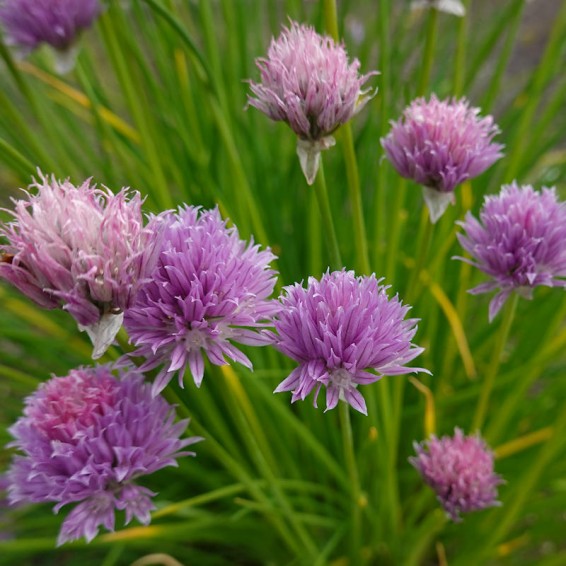Organic Chives Seeds
Allium schoenoprasum
- HOW TO GROW
- FAST FACTS
HOW TO GROW
Sowing: Chives grow well in a variety of soil types, though they prefer rich, well drained soil and full sun or partial shade. The seed can be started indoors about 4 weeks before the last spring frost; provide bottom heat, consistent moisture, and darkness for fastest germination. The seeds should sprout within 2-3 weeks; they can be transplanted 6-8" apart as soon as they grow big enough to handle safely, and there is no chance of frost. To direct sow, plant the seeds after the last frost of spring 1/4" deep in rows 18" apart, thinning to 6-8" apart as soon as the seedlings appear. Chives also grow well as a container plant. For companion planting benefits, plant chives with carrots; this improves the carrots' flavor and production.
Growing: Keep the soil moist while the seedlings are developing. Chives will spread vigorously with each year of growth, and can easily be divided for new plantings. After several frosts, cut the plant down to the ground.
Harvesting: The first year of their planting, chives should not be harvested to ensure their strong development. In the second year of their growth, harvest chives at any time after they reach a length of 6", cutting them 1/2" above the soil with a sharp knife or scissors. Take care not to cut all of the leaves, since the plant needs some left intact to continue healthy growth. Frequent cutting actually improves production, since this signals new growth; the growth of the flowers causes the leaf growth to slow dramatically and gives them a harsher flavor. The leaves keep in the refrigerator for about a week; they can also be frozen, but lose all flavor when dried. The leaves should be added to hot dishes at the last minute, since they soon lose their flavor with heat. The onion-flavored buds and flowers are also edible and make wonderful garnishes.
Seed Saving: Allow the flowers to mature and develop seed heads. When the seed heads turn brown, remove them before they open and drop their seed. Spread them out to dry in a protected location away from direct sunlight. Rub the dried heads to separate the seeds from the pods. Store the seeds in a cool, dry place for up to 2 years.
FAST FACTS
Latin Name: Allium schoenoprasum
Type: Open Pollinated, Heirloom, Cool Season|Warm Season
Life Cycle: Perennial
USDA Zones: 3, 4, 5, 6, 7, 8, 9
Seeds per Ounce: 10,000
Planting Method: Direct Sow
Sunlight: Full Sun
Height: 14 Inches
Color: Green
Bloom Season: Blooms Late Summer, Blooms Early Fall
Uses: Attracts Butterflies, Aromatic
DESCRIPTION
HOW TO GROW
Sowing: Chives grow well in a variety of soil types, though they prefer rich, well drained soil and full sun or partial shade. The seed can be started indoors about 4 weeks before the last spring frost; provide bottom heat, consistent moisture, and darkness for fastest germination. The seeds should sprout within 2-3 weeks; they can be transplanted 6-8" apart as soon as they grow big enough to handle safely, and there is no chance of frost. To direct sow, plant the seeds after the last frost of spring 1/4" deep in rows 18" apart, thinning to 6-8" apart as soon as the seedlings appear. Chives also grow well as a container plant. For companion planting benefits, plant chives with carrots; this improves the carrots' flavor and production.
Growing: Keep the soil moist while the seedlings are developing. Chives will spread vigorously with each year of growth, and can easily be divided for new plantings. After several frosts, cut the plant down to the ground.
Harvesting: The first year of their planting, chives should not be harvested to ensure their strong development. In the second year of their growth, harvest chives at any time after they reach a length of 6", cutting them 1/2" above the soil with a sharp knife or scissors. Take care not to cut all of the leaves, since the plant needs some left intact to continue healthy growth. Frequent cutting actually improves production, since this signals new growth; the growth of the flowers causes the leaf growth to slow dramatically and gives them a harsher flavor. The leaves keep in the refrigerator for about a week; they can also be frozen, but lose all flavor when dried. The leaves should be added to hot dishes at the last minute, since they soon lose their flavor with heat. The onion-flavored buds and flowers are also edible and make wonderful garnishes.
Seed Saving: Allow the flowers to mature and develop seed heads. When the seed heads turn brown, remove them before they open and drop their seed. Spread them out to dry in a protected location away from direct sunlight. Rub the dried heads to separate the seeds from the pods. Store the seeds in a cool, dry place for up to 2 years.
FAST FACTS
Latin Name: Allium schoenoprasum
Type: Open Pollinated, Heirloom, Cool Season|Warm Season
Life Cycle: Perennial
USDA Zones: 3, 4, 5, 6, 7, 8, 9
Seeds per Ounce: 10,000
Planting Method: Direct Sow
Sunlight: Full Sun
Height: 14 Inches
Color: Green
Bloom Season: Blooms Late Summer, Blooms Early Fall
Uses: Attracts Butterflies, Aromatic






